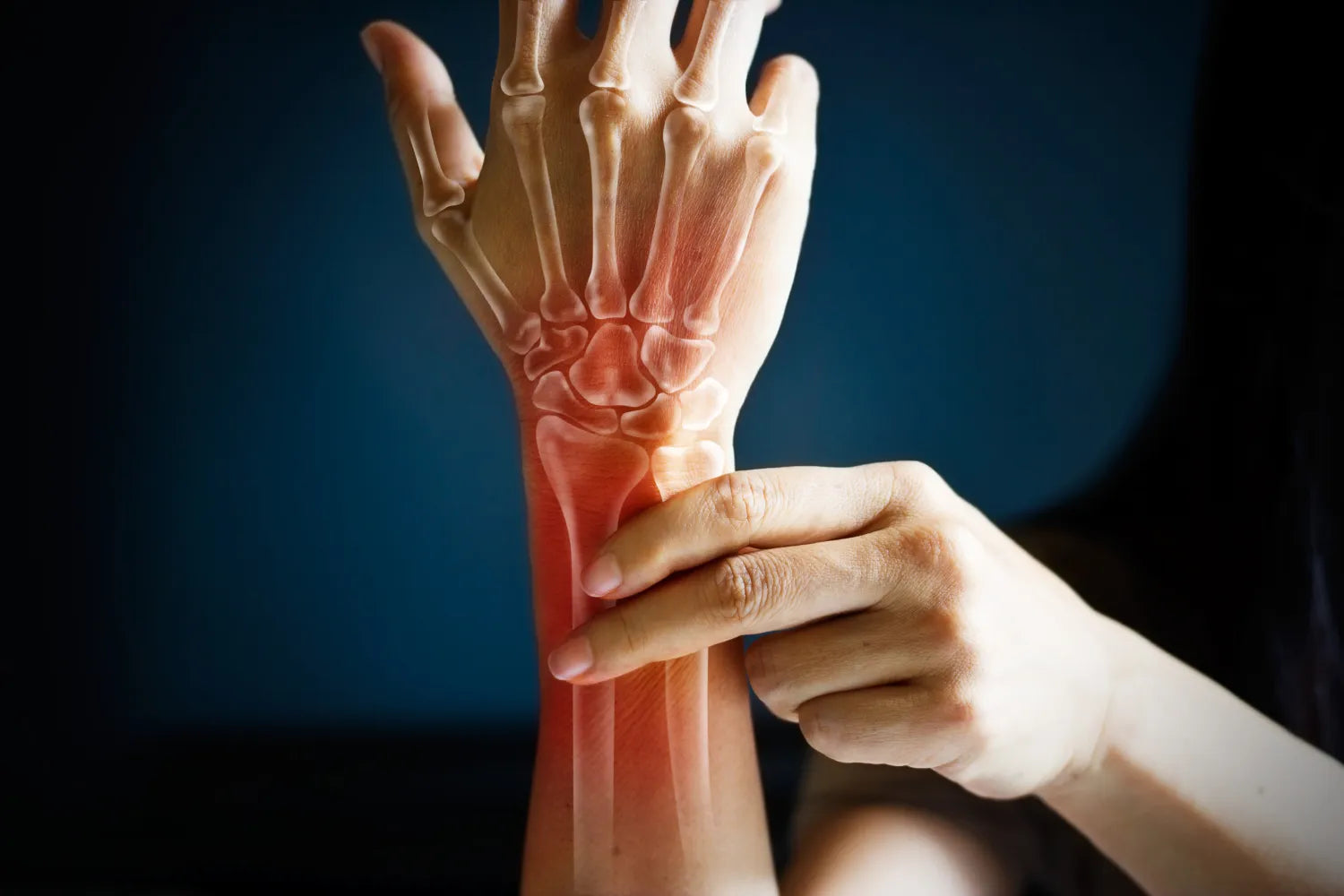
Wrist pain is a common issue that can affect anyone, whether it’s due to an injury, overuse, or an underlying condition. Our wrists are integral to countless movements, making them susceptible to discomfort when strained or injured.
Understanding the structure of the wrist, the causes of pain, and how to recognize symptoms can empower you to take control of your wrist health and seek the right care when needed.
What Are Common Causes of Wrist Pain?
Wrist pain can stem from a variety of issues, including injuries, repetitive stress, and chronic conditions. Identifying the cause is the first step in finding relief and preventing further damage.
Injuries and Trauma
Injuries to the wrist are among the most common causes of pain. From sports injuries to a fall onto an outstretched or direct trauma, these can lead to sprains, fractures, or even ligament tears.
A wrist sprain occurs when ligaments are overstretched or torn, often causing swelling and difficulty moving the wrist. In more severe cases, a broken bone, such as a scaphoid fracture, may occur. This type of injury often requires X-rays to confirm and can take time to heal due to the limited blood supply in certain wrist bones.
Repetitive Stress and Overuse
Repetitive motions, such as typing, lifting, or certain sports activities, can lead to overuse injuries. Tendinitis, an inflammation of the tendons, is often linked to repetitive stress. Another condition, De Quervain’s tenosynovitis, affects the tendons at the base of the thumb and can make gripping or twisting motions uncomfortable.
Overuse can also contribute to musculoskeletal discomfort, as it places continuous strain on the wrist’s ligaments and tendons. Without proper rest and care, these repetitive motions can lead to chronic pain or stiffness.
Chronic Conditions
Certain long-term conditions are also possible causes of wrist pain. Osteoarthritis develops when cartilage in the wrist joint wears down over time, often causing stiffness and discomfort. Rheumatoid arthritis, an autoimmune condition, can cause inflammation and swelling in the wrist, impacting its range of motion.
Carpal tunnel syndrome, one of the most common causes of wrist discomfort, occurs when the median nerve is compressed. This condition can result from repetitive motions, swelling, or other structural changes in the carpal tunnel.
Another common injury is a ganglion cyst. These fluid-filled lumps typically develop on the back of the wrist and may limit wrist motion or cause discomfort during certain movements.
How Are Wrist Injuries Diagnosed?
Paying attention to symptoms is crucial when addressing wrist pain. Discomfort may range from mild soreness to sharp pain that limits wrist motion.
Swelling, discoloration, and tenderness are common signs of an underlying issue, especially after an injury. Pain may also be localized, such as on the side of the wrist or near the base of the thumb.
When wrist pain persists or worsens, seeking help from a healthcare provider is an important step. Early intervention can help identify the cause and prevent further damage. During a physical examination, your provider may check for tenderness, swelling, or reduced range of motion.
In some cases, imaging tests like X-rays or MRIs are necessary to rule out fractures, ligament damage, or other injuries. For example, wrist fractures may not always be immediately visible but can cause long-term issues if left untreated.
Understanding the symptoms and getting a proper diagnosis ensures that you can pursue effective treatment options, whether for an injury, overuse, or a chronic condition.
Treatment Options for Wrist Discomfort
Wrist discomfort during bending or lifting can severely impact your ability to complete daily tasks and affect overall quality of life. But the good news is, there are ways to manage discomfort. Treating wrist pain effectively depends on the cause and severity of the issue. While some minor injuries can be managed at home, persistent or severe pain often requires a professional.
Immediate Care for Wrist Injuries
If you’ve experienced an injury, taking steps right away can help reduce discomfort and prevent further damage. Resting the wrist is key to allowing it to heal. A splint or brace can provide support and limit unnecessary movement, which is especially helpful for a wrist sprain or minor strain.
Applying an ice pack can help soothe swelling and discomfort in the first 48 hours after an injury. Over-the-counter medications like ibuprofen or naproxen, which fall under the category of NSAIDs, can assist in managing short-term discomfort and swelling. Using compression sleeves can help support blood flow to the wrist, which can aid in healing and comfort.
For more severe injuries, such as suspected wrist fractures or ligament tears, it’s important to consult a healthcare provider. X-rays or other imaging may be necessary to confirm the diagnosis and determine the best treatment approach. In some cases, a cast or surgical intervention may be required to properly stabilize a broken bone or repair damaged ligaments.
Ongoing Treatment for Chronic Conditions
When wrist pain is caused by chronic conditions like osteoarthritis, rheumatoid arthritis, or carpal tunnel syndrome, ongoing care is often necessary. Corticosteroid injections may be recommended to address swelling and provide relief in specific areas, such as the wrist joint or tendons.
Physical therapy can play a crucial role in recovery and long-term management. A physical therapist can create a tailored plan to restore range of motion, improve strength, and reduce discomfort. Therapy often involves targeted exercises that address the specific muscles and tendons affected, promoting better wrist function.
In some cases, non-surgical treatments may not be enough. For advanced carpal tunnel syndrome or severe ligament damage, surgery might be recommended to relieve pressure on the median nerve or repair structural issues in the wrist. Consulting with an orthopedic specialist can provide clarity on when surgery is appropriate and what to expect during recovery.
Preventing Wrist Discomfort and Injuries
Taking proactive steps to protect your wrists can help you avoid discomfort and maintain mobility.
Ergonomic Adjustments
Repetitive motions, such as typing, lifting, or sports movements, often contribute to wrist pain. Using ergonomic tools, such as keyboards and mouse pads with wrist support, can reduce strain during repetitive tasks. Adjusting your workstation to promote proper posture and alignment also helps minimize stress on the wrist joint.
Strengthening and Stretching Exercises
Strengthening exercises can build resilience in the muscles and ligaments supporting the wrist. Regular stretches improve flexibility, helping prevent stiffness and overuse injuries. Simple wrist stretches and hand-strengthening exercises are particularly beneficial for those prone to repetitive motions.
Rest and Recovery
Balancing activity with adequate rest is essential for preventing overuse injuries. Activities that involve high wrist impact, like pushups or racquet sports, should be paired with rest breaks to give your wrists time to recover. Using supportive gear during these activities can provide added protection.
Compression Gear
Wearing compression gear can provide additional support for your wrists during activities that involve repetitive motions or high impact. Compression sleeves or braces help stabilize the wrist joint, reduce tension, and support healthy blood flow, which may aid in recovery and help prevent discomfort.
These tools are particularly beneficial for sports, typing, or any task that puts consistent strain on the wrists. Incorporating compression gear into your routine is a simple, effective way to support wrist health.
When To Seek Help From an Orthopedic Specialist
Sometimes, wrist pain requires expert attention, particularly if the discomfort persists or limits your ability to perform daily activities.
Signs that it’s time to consult an orthopedic specialist include:
- Persistent pain, swelling, or reduced range of motion that doesn’t improve with home care.
- Visible deformities or signs of a possible broken bone, such as severe tenderness or discoloration.
- Numbness, tingling, or weakness in the hand, which may indicate nerve involvement, such as with carpal tunnel syndrome.
Orthopedic care focuses on identifying and addressing the underlying cause of your wrist pain, ensuring a targeted and effective treatment plan.
Staying Active and Comfortable with Copper Fit
At Copper Fit, we understand how wrist pain can affect your ability to stay active and enjoy your daily life. Whether you’re recovering from an injury or managing ongoing discomfort, taking the right steps toward care and prevention can make a significant difference.
Our mission is to provide comfortable, supportive compression gear that helps ease discomfort and maintain natural recovery. We believe in empowering you to stay mobile, feel your best, and stay active every day.
Taking care of your wrists means taking care of your overall well-being. If wrist pain is holding you back, explore your options and take the next step toward a more comfortable and active lifestyle. We’re here to support you on that journey.
Sources:
Anatomy of the Hand & Wrist: Bones, Muscles & Ligaments | Cleveland Clinic





